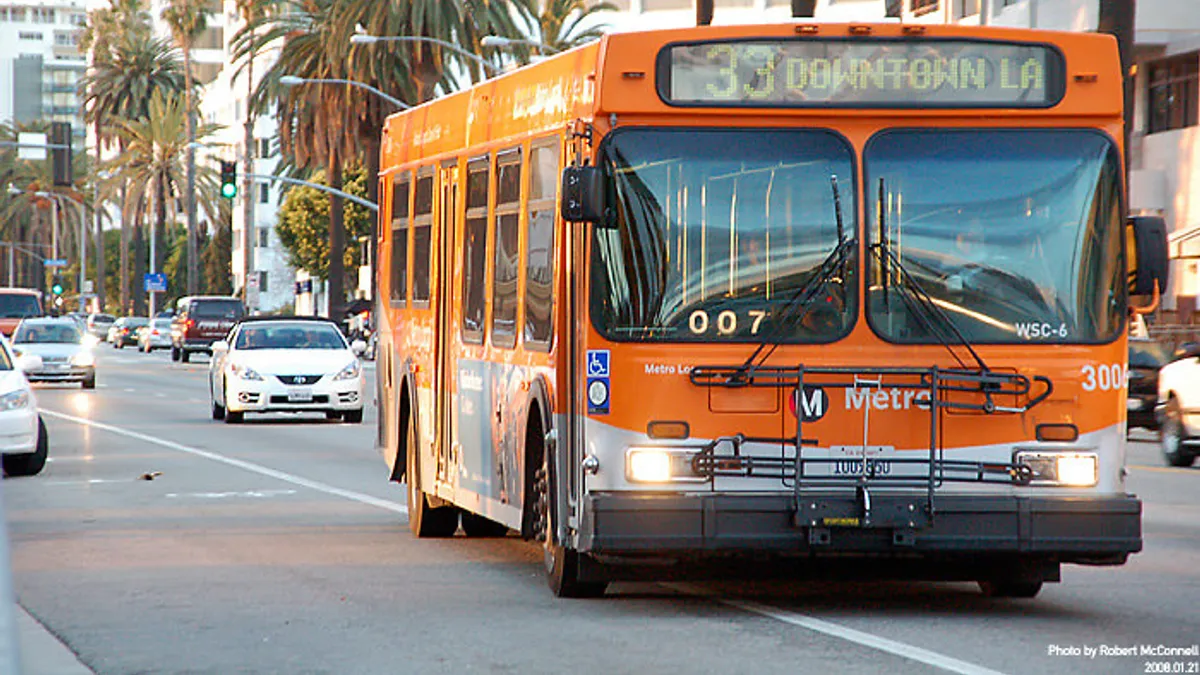Dive Brief:
- The Los Angeles County Metropolitan Transportation Authority, or Metro, unanimously approved moving forward with public review for the NextGen Bus Plan, formally ending a nearly two-year study period for overhauling the bus system. A series of community workshops will take place in February to gather public input and tweak the plan as necessary, and additional meetings will occur through April.
- The plan includes several key elements to improve service and boost ridership:
- Buses will arrive at least every 10 minutes for 83% of riders, compared to the current 48%.
- The number of bus lines running every five to 10 minutes will increase on weekdays from the current 16 to 29, and the number of weekend lines will increase from two to 14.
- The number of Los Angeles County residents who can walk to a bus line that arrives every five to 10 minutes will increase from the current 900,000 to nearly 2.2 million.
- If all goes according to schedule and final plan approval occurs this summer, the first phase of bus system upgrades could happen in December, with two other implementation phases occurring next year, Stephen Tu, director of service planning at Metro, told Smart Cities Dive. "Given the number of buses, routes and bus stops, we are not looking to switch overnight," he said. "This has been a really data-driven project as far as the first part of this NextGen bus study, but it's also been informed by extensively listening [to citizens]."
Dive Insight:
The NextGen plan was Metro's first comprehensive bus study in almost three decades. The impetus for the project was the nearly 25% drop in bus ridership since 2014, Tu said. Metro currently has about 800,000 daily boardings for bus trips and about 350,000 for train trips, and the goal of NextGen is to win back previous riders and attract new ones.
"We're looking at the data and public outreach to see how we can realign our bus network to be more relevant and reflective of the way Angelenos travel today," Tu said.
The ridership problem is not unique to Los Angeles; numerous reports, including the American Public Transportation Association's most recent quarterly report, show widespread year-over-year ridership decreases across the country.
During the public outreach phase, Metro will post an interactive online tool to help citizens understand the changes that would occur when the plan is implemented. Users will be able to drop pins on an interactive map and see the current bus trip for that route, and an overlay of what it will look like after the upgrades.
Equity has been at the forefront of the bus study and planning process. The working group deployed advocates to underrepresented communities to get feedback on what is most important to them. Metro analyzed numerous social equity factors including income, race, non-English speakers, zero-car households, non-driving youth and aging citizens. It aligned these factors in the plan to reach the communities most in need of transit service and system improvements.
Metro also took into consideration findings from its recently released report, Understanding How Women Travel. The agency learned that more than half of its customers are women, and 57% bring children on board transit. "That really changes the way we need to think about how we can make service attractive and convenient for people with extra belongings and strollers, and how can we make the system safer for people to travel," Tu said.
Metro found out during its equity-focused meetings that people do not always feel safe waiting at a bus stop, but they feel safer on board. Part of the reason for speeding up bus service is to reduce riders' time at bus stops and increase their safety.
The agency is also looking into the possibility of offering free bus fare to students throughout the county. That is expected to be discussed more extensively this spring. Last year, L.A. launched a free student fare pilot program on DASH, one of the Los Angeles Department of Transportation's bus services.












